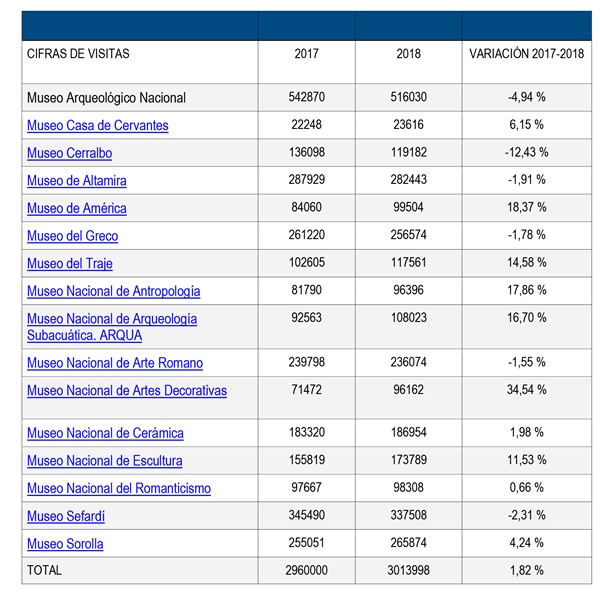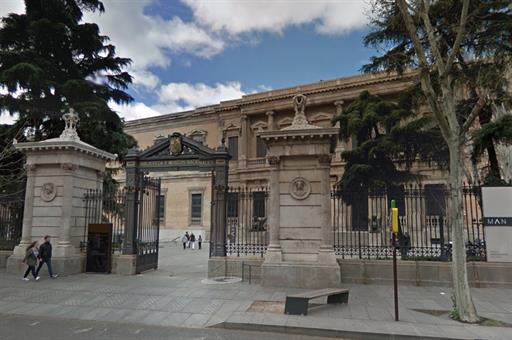Record number of visits
Visits to the 16 State-run museums number over 3 million for the first time
News - 2019.1.2
The number of visits to the 16 museums run by the Directorate-General for Fine Arts of the Ministry of Culture and Sport has grown steadily over the last decade to 3,013,998 in 2018, the highest ever figure since records began.
The growth in the number of visits of 1.8% on the previous year reflects the steady consolidation of museums as places of knowledge, leisure and participation. This greater involvement by the public is the result of a number of factors: better planning of exhibitions and quality programming for visitors of all kinds; the development of tourist itineraries; and strengthening the loyalty of a public that visits museums more and appreciates it as a valuable space for learning and personal enrichment in their lives.
In the first three months of 2018, the growth in the number of visits was particularly marked, at 13% more than in the same period in 2013.
The most visited museums continue to be the National Archaeological Museum, with more than 516,000 visits; the Sephardic Museum, with more than 337,000; and the Museum of Altamira, with more than 282,000. The Sorolla Museum received an all-time high of 266,000 visits, 4% higher than in 2017; and the González Martí National Museum of Ceramics and Sumptuary Arts received nearly 187,000 visits, 2% more than in 2017, recording its best result ever.
The museums of Valladolid have also posted increases: the National Museum of Sculpture recorded an increase in visits of nearly 12%, with more than 173,000; while the Casa de Cervantes Museum has posted a rise of more than 6%, with almost 24,000 visits.
Among the museums with the highest increases in the number of visits is the National Decorative Arts Museum, with an increase of around 35%, reaching an all-time high with more than 96,000. Also posting record figures are the Museum of the Americas, with over 99,500 visits, with a growth of more than 18%; the National Anthropological Museum, with more than 96,000 visits, and growth of nearly 18%, the Fashion Museum (Museo del Traje), with 118,000 visits and an increase of 15%; and the National Underwater Archaeological Museum, ARQVA, with a new all-time high of 108,000 visits, representing an increase of 17%.
More and better activities and services
These figures have been the result of improved programming, travelling exhibitions and collaboration between collections to allow greater and more varied public to discover the heritage stored by State-run museums. Among the good examples of this are the travelling exhibitions in Spain and abroad of the Sorolla Museum, such as the recently inaugurated "Sorolla tierra adentro" (Sorolla Inland) at the Museu de Arte Antiga in Lisbon; "La invención del cuerpo. Desnudos, anatomía, pasiones" (The Invention of the Body: Nudes, Anatomy, Passions), organised jointly by the National Museum of Sculpture and the San Telmo Museum of San Sebastian; and the participation of various museums in the exhibition "Spain: 500 Years of Spanish Painting from Museums of Madrid", which presented the great masters of Spanish painting in the San Antonio Museum of Art, Texas.
In 2018 the museums have made major progress in all aspects to connect with society in more depth and with a greater commitment. These improvements include:
- Improvements in their buildings, permanent exhibitions and services: This has been the case with the restoration of the facade of the National Archaeological Museum; the improvements of the installations and the foyer of the National Anthropological Museum; and the renovation of the air conditioning system in the Museum of Altamira.
- Restoration and expansion of collections: Examples of this are the acquisition by donation of two portraits by Rafael Tegeo; the restoration of the painting "La Noche" (The Night) in the headquarters of the National Ceramics Museum; and the restoration of the culverins from the ship Nuestra Señora de las Mercedes in the National Underwater Archaeological Museum.
- More variety and quality of temporary exhibitions: As demonstrated by the exhibitions "Al encuentro del Gran Espiritu. El Congreso Indio de 1898" (In Search of the Great Spirit: The Indian Congress of 1898) at the Museum of the Americas; "El Diablo, tal vez. El Mundo de Brueghel" (The Devil, Perhaps: the World of Brueghel) at the National Museum of Sculpture; "Grupo 13. Publicidad entre el arte y el diseño" (Grupo 13: Advertising between Art and Design) at the National Museum of Decorative Arts; "La vie en rose" at the Museo del Traje; "El Arte de reproducir el Arte. Pared, pigmento, píxel" (The Art of Reproducing Art: Wall, Pigment, Pixel) at the Museum of Altamira; and "Aún lo pueden todo: 50 años de Madelman Una mirada antropologica" (They Can Still Do it All: 50 Years of Madelman, an Anthropological View) at the National Anthropological Museum.
- Scientific Contribution to historiographic research and recovery: This is the case with the work done by the National Museum of Romanticism on the figure of Rafael Degeo in the first monographic exhibition on the painter; and the study of a portrait that until now was anonymous of two female figures from the viceroy period that has heightened our knowledge of the Hispanic and indigenous world from a gender perspective, concluding with the exhibition "La Hija del virrey. El mundo femenino novohispano en el siglo XVII" (The Viceroy's Daughter: the Female World in New Spain in the 17th Century) at the Museum of the Americas.
The educational and training work, development of courses, seminars and educational days and the creation of programmes linked to new publics and contemporary social, economic and cultural changes in dialogue with society, has led to a more open, diverse, inclusive and approachable museum with participatory projects for migrant communities. In 2018 the Museum of the Americas received a Pluma award for its contribution to the rights of LGTBI people and their visibility with the exhibition "TRANS. Diversidad de Identidades y Roles de Género" (TRANS: Diversity of Identities and Gender Roles).
Table: number of visits
 Ministerio de Cultura y Deporte
Ministerio de Cultura y Deporte
Non official translation





